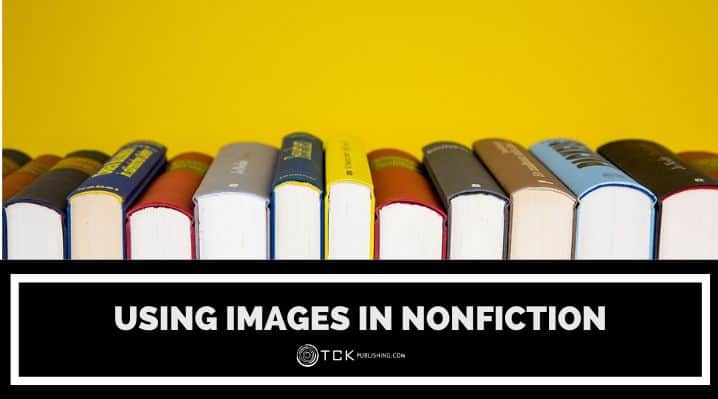
One of the usual dilemmas of being a nonfiction writer is deciding whether to include images in their books. It’s a big decision that changes a huge chunk of your writing process.
Images can make your book more engaging but come with some unique challenges. Let’s look at why you might want to use images, and why you might not.
The Pros of Using Images
Here are some common advantages to adding images in your nonfiction works. To clarify, we’re using “images” as a catch-all term including photographs, illustrations, charts, graphs, maps, etc.
1. Better Understanding
Images can make complex ideas easier to understand, especially abstract ones. For example, describing parts of a machine easily gets complicated and lengthy. Adding an illustrated cross-section makes it easier to visualize and memorize.
This way, you can break down big information into smaller, easier-to-understand information. It also helps that the majority of humans are visual learners.
2. Engagement and Immersion
Imagine reading a book that’s only text. It’s easier when reading fiction as you mostly let your imagination run. But nonfiction? It could work for memoirs and biographies, but people will have difficulty consuming educational books devoid of images.
Walls of text get boring fast. And when your readers get bored, they tend not to pay attention or drop your work altogether. Images break up the text with colors and let your readers enjoy your book in another way.
3. Emotional Impact
Images can make readers connect deeper with your prose. It makes your story feel more concrete and undeniable.
Your readers’ imagination can take them to all sorts of places. A picture, however, grounds them in reality. It gives them a glimpse of an actual object or event and the experiences surrounding them.
Good memoirs take advantage of this. They include images from significant moments of a person’s life to essentially tell the reader that “yes, this is me, and this did happen. See for yourself.”
4. Uniqueness
Images, especially ones taken by you and not sourced from others, set your book apart from other nonfiction books. They belong to you and can only be found within your work.
That holds a lot of value to people, especially if you have an image of something rare, personal, or interesting. It could even help you generate interest in your book. People love sharing interesting things on social media.
5. Marketing
A lot of promotional material is visual. Think of how bland yours would be without using images. Uploading teasers with images included not only gives visual appeal but also quickly conveys the topic of your book.
Food pics? A cookbook. Rare, historical photographs? Historical nonfiction. Flora and fauna? Probably a nature book. And so on.
The Cons of Using Images
Here are a few reasons you might not want to use images in your nonfiction book.
1. Money
Good images cost money. You might have to pay for the rights to use them or hire someone to take or create them.
It’s also costly even if you already own the images. They can significantly affect production costs and reduce your profit margins. For self-publishing authors, this is a major drawback.
2. Design Challenges
Including images means more work in designing and laying out your book. Design challenges also differ when creating a book for both print and digital formats.
Even a small change in page size can severely impact your book’s layout. Images also need to be high resolution and properly formatted so they look great in all versions of your work.
This often requires professional book designers, which adds to the cost and complexity of your book.
3. Distraction From Text
While images are excellent for understanding and engagement, they can also distract your readers from your main content.
Too many images clutter the book and interrupt the flow of the narrative. Your readers might find themselves constantly needing to re-read sections and actively ignore your visual aids.
You need to find the balance between your text and images. Find which parts of your prose will benefit the most with visuals. Let your readers use their imagination for the rest.
4. Copyright Issues
Using images in your book means navigating through copyright laws, which can be complex and time-consuming. You must ensure you have the proper rights to each image, whether by licensing them, creating them yourself, or using royalty-free and public domain images.
Failing to do so opens you up to a lot of legal headaches and fines. Copyright aside, it’s simply basic decency to ask for permission to use images that are not your own and give credit.
Tips on Using Images
If you choose to use images in your work, here are a few basic tips to keep in mind.
Choose relevant images.
Make sure the images you use fit the text and have a clear purpose. They should help explain or enhance your prose.
Quality over quantity.
Consider which parts of your book need visual reinforcement. Only use high-quality pictures, unless you have no other choice.
For example, if you’re writing a history book, you might be forced to use old, grainy photographs. Even then, they should still go through an enhancement process. Even a little bit of improvement helps.
High-quality images also give a more professional feel. This helps in maintaining your book’s credibility.
Use captions.
Brief captions give additional context to your images. It also helps your readers make a connection from one image to a particular section of text.
Find a balance.
Find a balance between your images and text. Spread your images out and make sure no part of your book is overwhelmed by them.
Keep a consistent style.
Your images should be cohesive to blend well into your text. Using images of varying quality and style can make it seem like they were carelessly thrown together.
Work with a professional to keep your images consistent. Set guidelines on size, color, placement, filters, and so on.
Give credit.
Always give credit to the creators of the images you use. Proper attribution includes the creator’s name, title of the work, source, and type of license.
Giving credit isn’t only about avoiding legal trouble. It’s also about respecting the work of others. Most licenses will require you to do so anyway.
Should You Use Images in Your Nonfiction Book?
Adding images to your nonfiction book can be very beneficial. They help explain ideas and make your work more engaging and marketable. However, it also means more work and cost.
There’s no one right answer for every book or writer. Think carefully about your specific situation. Consider your topic, readers, goals, and resources. Would it make sense to use images knowing what you know about these four elements?
Remember, images are there to enhance your work, not replace it. Whether you use them or not, your writing and what you share through it should be the main focus of your book.
Have you used images in your nonfiction book? Share your experience below!
If you enjoyed this post, then you might also like:
- 10 Free Meme Generators for Creating Your Own Shareable Images
- The Best Photo Editing Software: 10 Graphic Design Tools You Can Use to Make Great Images
- The Best Free Stock Photo Sites: How to Get Royalty-Free Images for All Your Creative Projects

Cole is a blog writer and aspiring novelist. He has a degree in Communications and is an advocate of media and information literacy and responsible media practices. Aside from his interest in technology, crafts, and food, he’s also your typical science fiction and fantasy junkie, spending most of his free time reading through an ever-growing to-be-read list. It’s either that or procrastinating over actually writing his book. Wish him luck!
